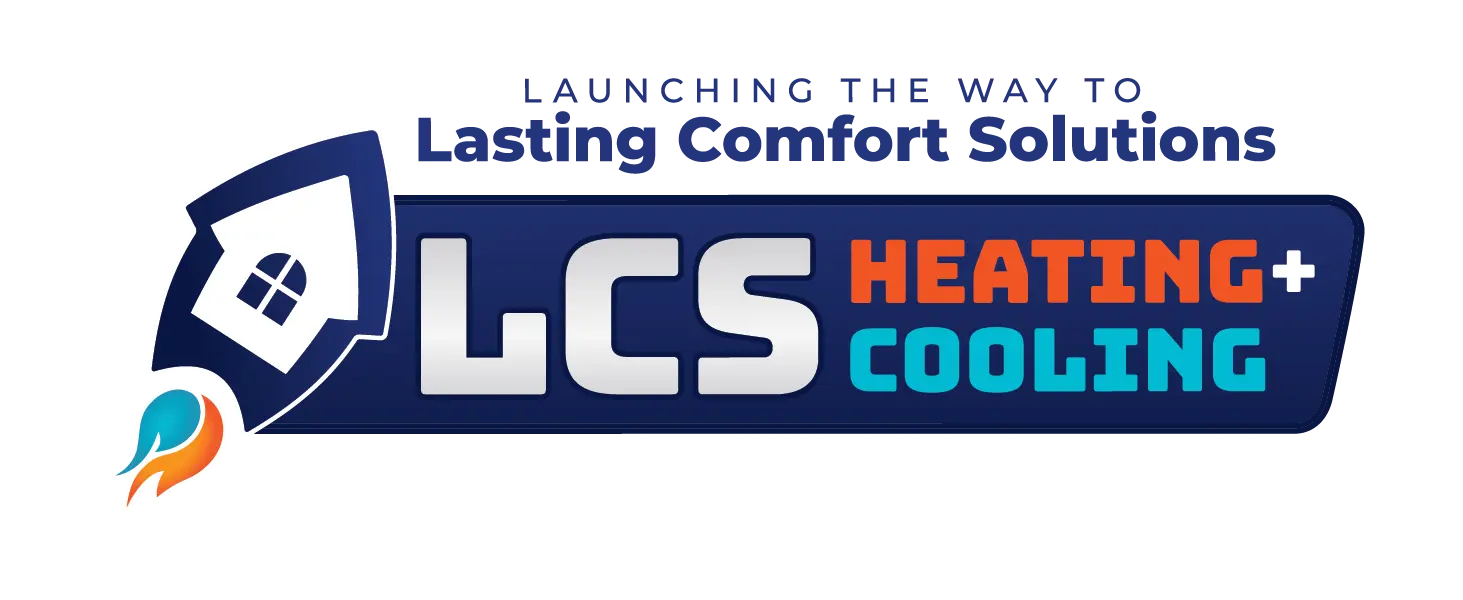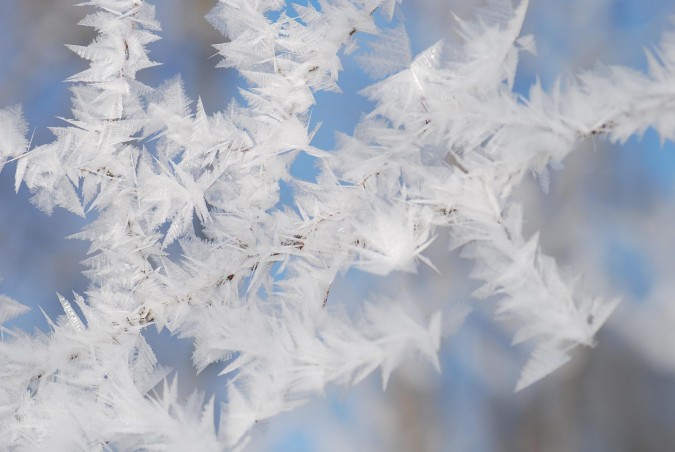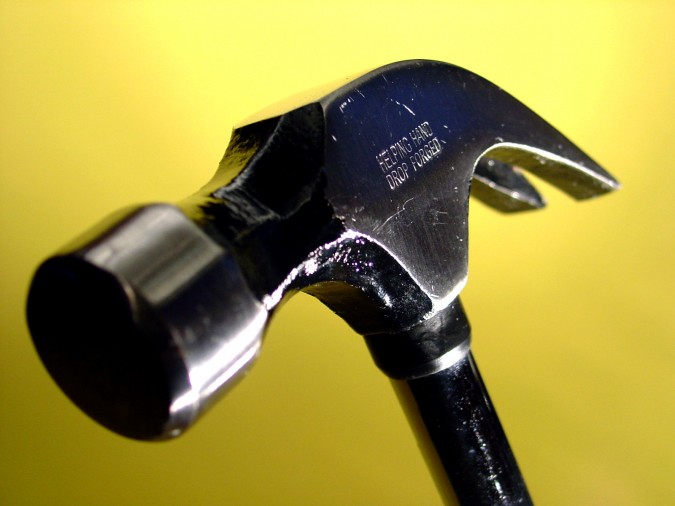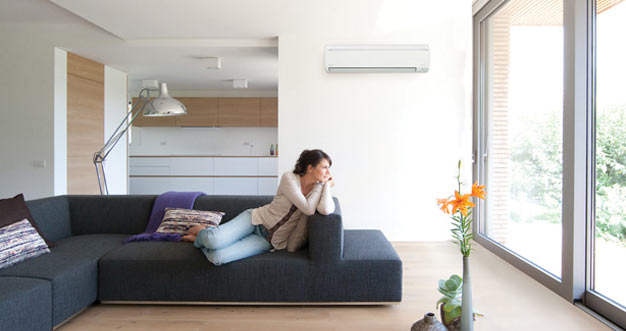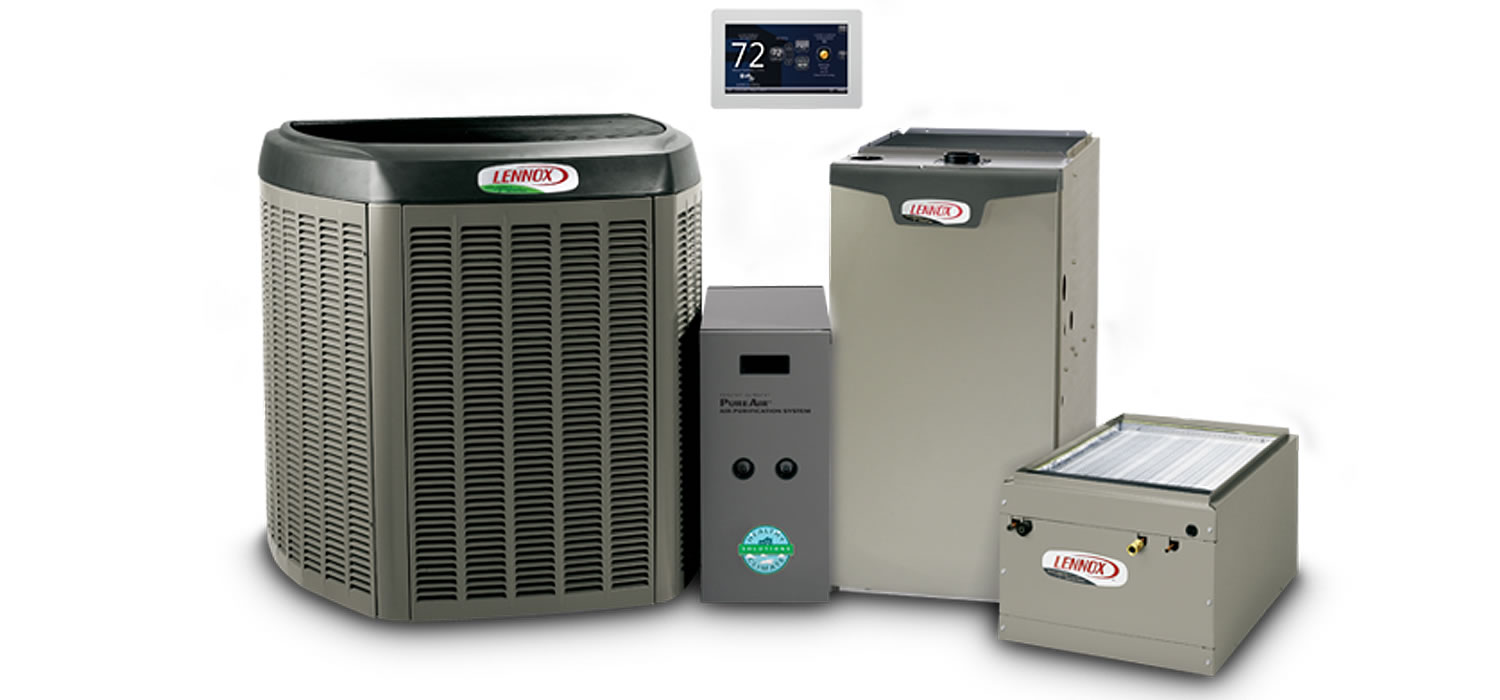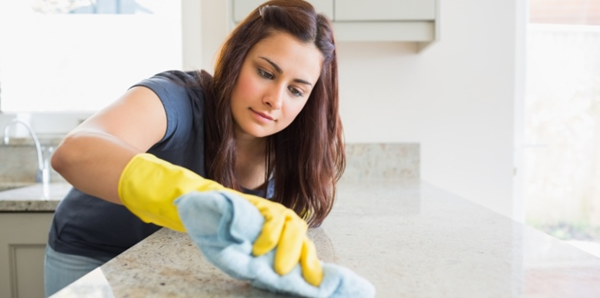It can be so difficult to feel cozy in winter when there’s freezing cold air outside and harsh, dry air inside. If your skin is dry or itchy, or it seems like you’re getting shocked every day in your home, you’re probably suffering from low humidity.
Fortunately, a humidifier can offer an easy fix. A lot of homeowners use a whole house humidifier to keep dry air away and get their home’s humidity levels between 30 and 45 percent. Regulating your indoor air does wonders for creating a comfy-cozy home during the cold months. Once you’ve got one of these systems installed, you’ll wonder how you ever made it through winter without it!
5 Reasons Why Homeowners Love Whole House Humidifiers:
1. Helps prevent disease and offers allergy relief.
Having some moisture in the air is actually good for breathing. It helps your body block dust, dirt, or bacteria and viruses from entering your lungs and making you sick. The right humidity levels in your home will help protect your respiratory and immune system, whereas dry air just makes it harder for us to stay healthy.
We don’t usually think of having allergies in winter, but dust mites and other indoor allergens like pet hair are still around every season. And because our indoor air gets drier when we turn our heaters on, these allergens have easier ways of spreading. Boosting your air moisture to the right levels can prevent those irritating particles from getting into your lungs. The right humidity levels help keep your body’s natural defenses strong.
2. Keeps skin soft and helps with chapped lips.
Low humidity will attack your skin and dry it out, and flaky, itchy, or rough skin are sure signs of dry air in your home. In extreme cases, your skin may even crack or show symptoms of eczema.
Installing a humidifier helps your skin stay hydrated year-round. A whole house humidifier improves your air quality and gives you a comfortable air moisture level all throughout your home so you don’t have to apply lotion multiple times a day. With good home humidity levels you’ll notice your lips are better protected in winter too.
3. Protects hardwood floors, door jambs, and furniture.
Just like your skin, your wood furnishings can start to crack with dry air. When humidity levels are too low, the air in your home will try to find moisture wherever it can—which means your hardwood floors, walls, door jambs, furniture, and even your piano are at risk of drying out, shifting, or splitting.
Preventing dry skin is great, but proper humidity levels also go a long way in maintaining the structure of your home. This can be one of the most costly problems related to dry air. Think of it this way: A whole house humidifier not only helps protect every room in your home, but also everything in it!
4. Stops annoying static!
Static electricity goes wild in dry air, and it’s easy to get shocked in winter with low humidity. Returning some moisture to your home’s air helps keep static from building up. There a lot of bizarre tricks (like putting a safety pin on your shirt collar!) you can try to remove static electric in your home, but getting a humidifier is your best bet.
It’s a lot harder to get shocked when your humidity is in check. Whole house humidifiers keep humidity levels at a comfortable 30 to 45 percent in winter. When they’re up and running, you don’t have to be shy about petting your cat or dog, brushing your hair, or giving someone a hug—the static shouldn’t bother you anymore.
5. Lets you breathe better and sleep easier.
Dry air can lead to dry throats, dry coughs, and even nose bleeds. A lot of homeowners find extra health benefits in their sleep with a whole home humidifier.
Nasal passages can feel irritated when humidity levels are too low in winter, but regulating moisture with a humidifier can help you feel better both day and night! A whole home humidifier can often improve your breathing and sleep schedule because you’re less likely to wake up with a dry cough or sore throat when your air moisture is at a comfortable level.
For more information about whole house humidifiers, check out our quick humidifier video on YouTube and other “How To” clips on our video page. There’s no reason to stay static-y in winter! If you’re ready to be done with dry air for good, reach out to your local heating and cooling experts to find a humidifier that’s right for your home.
February 18, 2016
We all know Indiana winters are unpredictable, but it can be pretty difficult to stay warm when temperatures drop unexpectedly. If you find yourself cranking up the heat, consider some of our budget-friendly solutions. These tricks will help keep your home warm during any cold spell.
1. Replace your dirty air filters.
A dirty air filter may not cause you any problems when the weather is mild, but it’s definitely something to check in winter. If we’ve got cold or freezing temperatures outside, your filter could very well be your biggest roadblock to a toasty home. Before you blame your furnace for the lack of heat, be sure to take a quick look at your filters.
Dirty filters restrict air flow and make it harder for your furnace to keep up without using loads of energy; and if your filters are old and dirty, there’s a good chance your furnace won’t be able to raise your temperature at all. Changing your filters regularly, and making sure to check them in the colder months is definitely a smart way to help your furnace run efficiently.
2. Check your attic insulation.
Proper insulation saves energy and makes your home resistant to heat loss by creating a barrier between your warm home and the cold outdoors. One easy way to see if your home is losing heat is to compare the amount of snow left on your roof to your neighbor’s. If your snow is melting fast, you’ve probably got poor insulation. Even if your furnace is working fine and your thermostat is set to high heat, you might still feel cold because all the heat is escaping to uninsulated areas. Warm air rises and escapes to your attic space if it’s not insulated—meaning your furnace is heating your roof instead of the rest of your home!
Check your attic space in winter to make sure you’re not losing heat to poor insulation. The U.S. Department of Energy has a few tips for insulation, but a good rule of thumb is to make sure your attic’s insulation is at least 12 inches thick. One of the most effective ways to insulate your home is to make sure your attic access door is insulated—plus it’s a really cost-effective fix!
3. Keep your thermostat at one temperature.
This low-tech solution is kind of counterintuitive, but it’s our best advice for battling freezing or below-freezing temperatures outside. In milder months, a lot of homeowners like to lower their thermostat temperature at night to save on energy. When we’ve got really cold, or even record breaking cold weather though, it’s hard for your furnace to make up even a 5 degree difference from nighttime to daytime.
Rather than get stuck with a cooler temp in the day, we suggest leaving your thermostat on a set temperature in winter that’s comfortable for both day and night. If you have a programmable thermostat, try using the “hold” function for your ideal temp. This is a great feature that helps your home stay warm 24/7 without any temperature fluctuations or thermostat checks. A programmable thermostat even helps you control energy costs, and can cut your heating costs by 35%.
If your home is still extra-chilly in the winter months, you can always call on your local HVAC company to help you solve the problem. A specialist can help you review your home’s current setup and make sure all your heating components are working at their best levels.
And if for some reason your furnace actually quits on you in winter, please call your local HVAC specialist right away! It doesn’t take long for your home’s temperature to drop drastically low if your furnace stops working, so be sure to put in a call ASAP. There might be a lot of other homes without heat too, so you’ll want to get on the technician’s list early so your home can go back to being cozy and warm.
February 1, 2016
Wreck or Protect? How Water Affects Your Appliances
A guest blog article by: Indy Soft Water
We all want to get the most out of our home appliances, but one of the biggest ways to prevent repairs (outside of regular maintenance services) is something so simple, we often forget it—our water! The kind of water you use in your home goes a long way in either wrecking or protecting your water-using appliances. Without the right water systems in place, you’re making your appliances age a whole lot faster.
Tap water in Indiana is notoriously “hard.” This means that it has high levels of dissolved minerals that can damage your appliances. While these minerals are naturally-occurring (calcium and magnesium compounds get picked up from rocks during the water cycle), hard water is a real nuisance around the home.
These are some of the top symptoms of hard water:
- Water Spots on your “clean” dishes
- Crusty Buildup on your shower head and around your faucets
- White Film inside your tea kettle or pots after boiling water
- Soap Scum in your sinks or around the bathtub
Hard water leaves minerals behind when it evaporates from your dishes and bathroom fixtures. Unfortunately, it also leaves these deposits in places you can’t see—like in all in the intricate parts of your appliances. These deposits build in rock-hard layers called “lime scale.”
The inner workings of your dishwasher, laundry machine, water heater, and humidifier all fall victim to lime scale buildup when your home uses hard water. Your water heater is particularly vulnerable against hard water. Sediments and lime scale build up on the bottom of your heater and on other internal parts. With too much hard water sediment at its base, your water heater can overheat, damage its electrical parts, and basically render the system useless by reducing capacity and efficiency. Because the scale is heated first, rather than the water, your system ends up wasting energy and your water won’t get as hot as it should be. All the more reason to get preventative maintenance services scheduled!
Similar hard water problems can occur with a whole-house humidifier, too. As more and more minerals pile up on your system they’ll interfere with how well your humidifier functions by plugging the solenoid valve, that open/close device that allows water to flow. Keeping a clean humidifier—and water heater—has a lot to do with using water that’s “soft,” instead of hard water.
This is why people love soft water:
- Spot-free dishes
- Hair feels smoother
- No more mineral buildup
- Soap lathers and rinses better
- Longer lifespan for water-using appliances
- And the list goes on...
A lot of homeowners choose to install a water softener system because it removes the minerals in hard water and helps protect their major home appliances from getting sediment buildup. Like the name suggests, when you have a softener in place, your home’s water becomes wonderfully “soft!”
Got any questions about whether a water softener is right for you? Check out the Indy Soft Water website, send us a message, or call 31-228-9822. We’ve been your local water experts since 1964, and we’re always happy to chat!
Indy Soft Water is proud to serve the following Indiana areas: Carmel, Fishers, Greenwood, Indianapolis, Noblesville, Westfield, and Zionsville.
November 30, 2015
The last thing on anyone's mind right now is HVAC. It's too warm to need the furnace and too cool to need the air conditioner. We do live in Indiana though so that can change in just 24 hours! We want to provide some tips for things you can do on your own to keep your furnace and air conditioner running at its best. We present the LCS Top Ten of Homeowner DIY HVAC Tips:
10. During cold or hot months, keep the programmable thermostat set within 3 degrees of each setting. A furnace and air conditioner will have to run for a very long time to make up the temperature difference. If you have an electric furnace
and heat pump, the electric furnace will come on as well to reach the set temperature. Since an electric furnace runs at a higher cost, it counters the savings that you might have had with the lower initial temperature.
9. Keep the weed eater and lawn mower away from the control wiring of the air conditioner. The wiring should not be hanging down but if it is, be careful when mowing and weed eating. It's not a high voltage wire but if it gets cut with a weed eater or mower, you can get shocked and it can take out the air conditioner. If the wiring is loose or hanging down, tie it up with electrical tape or have a technician tie it back when they're out doing annual maintenance.
8. If you are experiencing high utility bills, call the gas or electric company first. Ask the utility company if there's been an increase in the therm or electric rate. Ask if your bill compares to the average of others in your neighborhood. You can get great information about what your utility bill should be running. If there isn't a good reason for the higher bill, then it might be time to have a technician out to make sure the system is operating properly.
7. Move furniture away from registers. It's not uncommon to see a couch over a register or a bookcase pushed up against a register. Not only can the heat dry out your furniture but it also prevents the air from properly traveling throughout the rooms.
6. Keep registers open. A very common problem in two story homes is a temperature swing between the upstairs and downstairs. Homeowners try to fix this problem by closing registers upstairs or in some rooms. Keep the registers open. Closing registers can restrict air flow and cause the furnace to run hot. This can ultimately shorten the life of parts inside the furnace such as motors. It can also make the air conditioner freeze up by reducing the volume of air that the system needs to expel throughout the house. This is comparable to running the system with a dirty filter.
5. If you notice a noise, smell or problem, call on it right away. If you notice something unusual, don't ignore it. It's rare that an HVAC issue will go away or resolve itself. Noises and smells often mean that a part is getting weak or going out. A little critter could also have gotten inside. Address these issues before your furnace or air conditioner goes completely out. It's no fun being without heat on a cold day or without a/c when it's hot out!
4. Keep dogs away from the air conditioner. Animal urine will degrade the a/c fins. There's not much that can be done to fix the fins once this happens so it's best to make sure the fur babies stay away.
3. Replace the batteries in the thermostat. If the thermostat goes blank, check to see if there are batteries that need changed. Not all thermostats have batteries, but if it does, it's likely AA or AAA batteries that need changed.
2. Pick up leaves that are around the air conditioner or heat pump. Leaves, cottonwood, branches, etc can gather around the air conditioner. Keep these things cleaned away so the outdoor unit can breathe.
1. CHANGE THE FILTER! This is the number one thing to do to keep your furnace and air conditioner running efficiently! A dirty filter causes restricted air flow and can ultimately cause the system to stop working. If you have a 1" filter, check it once a month. If you have a 4-5" filter, check it every 3 months. It may not need to be changed at that time but it's good to check it to make sure. It's also a good idea to keep extra filters at the house. That way, you always have one on hand when it's time for it to be changed.
A couple of other tips are to caulk or re-caulk around windows and doors. It's also a great idea to check the insulation in your home. If you don't have at least 12-15" of insulation in the attic, you'll want to consider adding more!
Keeping up on these things can not only save you money but can save you from the inconvenience of being without heating or cooling during those hot and cold months. HVAC equipment is definitely an investment. Protect your investment by following our Top Ten tips!
April 23, 2015
Big news in 2015 for the HVAC industry! Have you heard!? There's a new Seer minimum in place! Okay, let's be honest, unless you're in the HVAC industry working with this every day, this is likely not very exciting news. There's a pretty good possibility that you haven't even heard about it! We're here to explain what the new minimum is, what it means, and how it affects you.
A Seer rating is an energy efficiency rating on air conditioners and heat pumps. At the end of 2014, the minimum Seer rating was 13 seer. The new minimums affect some parts of the United States differently than others. For these purposes, the U.S has been divided into a North Region, South Region, and Southwest Region. Since we're located in Indianapolis, we'll focus on the change in Indiana, which is in the North Region.
What is the new minimum? Effective 01/01/2015, the new minimum Seer rating for heat pumps has changed from 13 Seer to 14 seer. For now, air conditioners are staying the same at 13 Seer.
What does this mean? 13 seer heat pumps are no longer being manufactured. When you are ready to replace your current heat pump, you'll likely be quoted at least a 14 Seer. A 14 Seer heat pump will come at a higher initial cost than a 13 seer heat pump but there's also more energy savings with a 14 Seer.
Can I still get a 13 seer heat pump? For a while, there will be 13 seer heat pumps that were manufactured in 2014 or before that are still available. The entire U.S. has moved to a minimum 14 Seer heat pump rating, so once those 13 seers that were manufactured in previous years are gone, they're gone.
Does this affect me now? We saw an advertisement recently in which the message was implying that everyone had to replace their heat pumps now to adhere to the new standards. This is simply not true. The new standards are for new equipment going forward. The new standard does not say you have to upgrade right now! It's not illegal to currently have a 13 seer heat pump installed in your home. It just means that when it's time for new equipment, 14 seer is the minimum.
Does this affect me if I have an air conditioner? No, it does not! The new standard in Indiana is for heat pumps only. Eventually, yes, air conditioners will also move to a minimum 14 seer rating but it's not happening this year in Indiana or any of the North Region. In other states (the South and Southwest Regions), the minimum has already changed for both air conditioners and heat pumps.
We hope this helps to answer your questions about the new minimum seer ratings!
March 24, 2015
We've received several calls this winter about rising utility costs. People have been concerned because they're seeing upwards of $400-$500 electric bills. Yikes! We'd like to share some tips on what you can do to find out if you're experiencing "normal" bills or if there might be a problem causing them to be high.
There are things that can be done to your home to increase efficiency. These things include insulating, caulking, checking for drafty areas, etc. For our purposes now though, we're going to assume that your house is in the same condition this year as it's been in prior years.
So, is your electric bill high or might there be an HVAC problem?
First things first, call your utility company. Ask what the neighborhood average is and compare to your bill. Ask if the kilowatt rate has changed. Ask if the therm rates have changed. This will give you a good idea on whether your bill is comparable to that of your neighbors. It'll also make you aware of rate increases that have happened which could contribute to higher bills from previous years.
If your electric bill is higher than the neighborhood average, here are some other things to consider:
If you are all electric, you should have a heat pump and electric furnace (also called an electric air handler). This is the most efficient type of HVAC system to have in an all electric house. Many people set their programmable thermostat to be one temperature during the day and another at night. If you are all electric, do not set the temperature difference to be more than 3-4 degrees apart. Larger temperature differences will cause the back-up electric to come on to supplement the heat pump. It's costly to run the auxiliary heat. The savings that you are getting from the lower temperature is being offset (or costing more) by the back-up electric running to catch up.
Do you change your filter regularly? How long has it been since your furnace has been cleaned and tuned? Dirty filters restrict air flow and cause the system to run longer to heat the house. This causes a higher electric bill. Dirty filters over a period of time or a lack of filters at all can result in dirty coils. A dirty coil can also restrict air flow. If the heat pump isn't working, the electric furnace is running by itself to heat the house. It's expensive to run an electric furnace by itself. The average amp draw on a heat pump is 6-15 amps. The average amp draw on an electric furnace with a 10kw auxiliary heat kit is 41-44 amps. That's a big difference which is why you want your heat pump running efficiently.
Do you keep registers closed throughout the house? If there's a temperature difference between the upstairs and downstairs, for example, people tend to close the registers in a room or area of the house. Do not close registers. This can also restrict air flow, causing the system to overheat and short cycle. This means the furnace will be shutting down and turning back on more than it should be, which uses more electricity and costs you more.
One more thing to keep in mind. Some people have a high efficient heat pump system and then are surprised by their electric bills when it's really cold outside. They get a high bill and think...but I just got a high efficient system. Heat pumps are most efficient in the heating season when it's between 35-60 degrees outside. In Indiana, it's not unusual to have 0-20 degree days (or weeks). When it's that cold outside, heat pumps need the auxiliary heat from the electric furnace to keep up. The heat pump can't keep up by itself meaning you're losing that efficiency rating because the electric furnace is doing most of the work. It's costly to run auxiliary heat compared to a heat pump or gas furnace. If you buy a high seer heat pump, it's important to understand that the seer rating is mainly for the summer months.
We hope this has been helpful! If you continue to have high electric bills, give us a call. Maybe there's a problem with the heat pump causing the auxiliary heat to run more than it should. Maybe there's a bank of heat not working in the electric furnace. It's worth checking out, especially if those high electric bills are causing you a lot of stress!
March 12, 2015
Compared to some Indiana winters, we've been pretty lucky this year! Winter is still winter though and we're right in the middle of it. With a couple of cold months still left, the question should be asked: How's your home holding up? We'd like to share some customer HVAC questions we've had over the past month as well as provide some tips to protect your home against the harsh winter days.
Q: My furnace is running but it's not keeping the temperature that I have it set at.
A: Have you checked your filter? A dirty filter restricts air flow and can affect the operation of the furnace. During milder outdoor temperatures, a filter that's a little dirty may not affect anything at all. During colder outdoor temperatures, the same filter can cause the furnace to have to work harder and fall behind. Filters may have to be changed more often than usual during extreme outdoor temperatures.
Q: I usually keep my whole house humidifier set at 40% but I've recently noticed that my windows are sweating.
A: When outdoor temperatures get really cold, you may have to turn your humidifier down. Once the outdoor temperatures warm back up a little, you can turn it back to it's normal setting. When there's too much of a humidity difference between the outdoors and indoors, you may notice some sweating. It's a common misconception that the colder it is, the higher the humidifier should be turned up. The opposite is actually true. In addition, houses differ in how insulated they are (amount of insulation, leaky windows and doors, etc). Therefore, one house may notice window sweating at 30% and another at 40%. Adjust the humidistat up or down accordingly.
Q: Why is there ice on my heat pump?
A: There's not a cut and dry answer for this. A heat pump has a defrost cycle that it goes through to melt the ice under normal circumstances. If ice is there at one time and gone the next time you look, then it is likely operating normally and has gone through the defrost cycle. If you see ice for days on end, there's possibly a problem. It could be a number of things. Turn the heat pump off by taking the thermostat to emergency heat. That will help thaw the ice so it can be properly diagnosed.
Q: My electric bills are outrageous!
A: If you are all electric, our first question will always be: do you have a heat pump or air conditioner? An electric furnace running by itself to heat your home is very inefficient and expensive. If you have an air conditioner with electric furnace, it's worth considering replacing the air conditioner with a heat pump. If you do have a heat pump and still have unusually high electric bills, there could be a problem with the heat pump or furnace. The heat pump could be under-charged, it could not be going into defrost mode, a bank of heat in the electric furnace could be stuck on, etc. It would be worth having your equipment looked at if you feel like your utility bills are high.
Here are ten other tips that we have to prep your home for colder days to come:
*Have your furnace cleaned and tuned-up
*Test sump pump
*Caulk around windows and doors
*Remove hoses from outdoor spigots
*Check insulation in attic. It should be a minimum of 12 inches
*Check door thresholds for gaps
*Plug in carbon monoxide detectors if you have gas appliances (stove, furnace, water heater, etc)
*Reverse ceiling fans
*Have your fireplace, chimney and vents inspected to make sure all is in good condition
*Clean gutters
Feel free to reach out to us if you have any additional questions. Stay warm and cozy!
January 29, 2015
There's a common passion among all of us at LCS Heating and Cooling. Well, in addition to home comfort and the mechanics of HVAC that is! The common passion is animals. We love dogs, we love cats, one of our techs even has a rabbit! We're just animal people. It never surprises me to get a random picture throughout the day of a dog or cat. It's usually a customer's pet that Travis takes a picture of and says- check this little one out! One of our installers even sent a picture of a customer's pet turtle that hung out in the backyard with them while they changed the heat pump. So, where are we going with this?
We were all talking a few weeks ago about wanting to have some "community projects." We're excited to tell you about our first one! One of our customers is Freeland Animal Hospital (www.freelandanimalhospital.com). They are located at Pendleton Pike and Sunnyside in Indianapolis. They are fantastic people and care so well for their furry clients! Each year, they have an Angel Tree in which they accept donations of dog and cat food, treats and supplies. All donations then go to a local rescue. This year the local rescue is PAWS (http://www.pawshancock.org), located in Greenfield.
Now through the end of the year, LCS Heating and Cooling, LLC has the following "Promotion" going on:
**For each new customer that signs up for Annual Maintenance (our Energy Savings Plan), we will donate a bag of dog or cat treats. Here's the link for more information about our Energy Savings Plan for your HVAC equipment: https://lcstempsite.dreamhosters.com/esp.html
**For each new furnace install, we will donate a 5lb bag of dog or cat food.
**For each new full system install (furnace & air conditioner), we will donate a 15lb bag of dog or cat food.
Will it be dog or cat food? The choice is yours!!
We are so excited to help a local rescue that helps so many dogs and cats each year. Who do you know that's thinking about having some HVAC work done? We greatly appreciate your referrals and personal business. The animals will too!
November 10, 2014
We get lots of questions regarding HVAC maintenance. This is a good thing! It means people care about their HVAC investment. Since we're entering air conditioner season, let's focus on questions relating to air conditioner maintenance:
- What is air conditioner maintenance? Preventative maintenance is completed on the a/c to ensure that it is running properly and as efficiently as possible. The air conditioner is cleaned and there are many components that are checked. If a reading is off or out of range, the homeowner will be made aware. Keeping the air conditioner clean also ensures proper air flow.
- Can I turn my air conditioner on before maintenance has been completed? Yes! The air conditioner can certainly run before maintenance is done. Keep in mind that maintenance keeps it running as efficiently as possible.
- What months do you schedule maintenance? We generally start scheduling maintenance mid-April, depending on the weather, and continue to schedule throughout the summer. It's more important that maintenance is done each year rather than it being done a specific week or month.
- Can the service be completed if it's raining? We will reschedule your maintenance appointment if it's raining or below 60-65 degrees outside. Although the techs do have raincoats, we don't want some of the tools and gauges out in the rain. We also don't want your a/c exposed to the moisture. The new R-410 refrigerant attracts moisture 10 times more than the old R-22 refrigerant. We don't like to take chances, so we'll always reschedule if it's raining. In addition to being dry outside, it also needs to be at least 60-65 degrees outside. If it's colder than that, the temperature drop and readings could be inaccurate. Accuracy is key, so we will reschedule if it's too chilly outside.
- How will I know what the technician does during the service? The technician will complete an invoice detailing everything that was completed during the maintenance service. He will also let you know how everything looked and answer any questions you have about your system.
- How much does an annual maintenance plan cost? Our plan is $150 per year. That includes the maintenance service on the a/c in the spring or summer and the maintenance service on the furnace in the fall/winter. Other benefits included with the plan are: No service call if a return visit is needed within 30 days, $10 off service call, 15% off repairs, 15% off indoor air quality (humidifiers, filters, thermostats, UV lights, etc) and no overtime rates if service is needed in an evening, weekend or holiday.
- Does maintenance guarantee that my air conditioner will not break down? Air conditioners are machines and can break down at any time. That being said, there are issues that can be found during maintenance and either repaired at that time or at least brought to the homeowner's attention. For example, the technician may see that a motor reading is in range, but on the high end. While it doesn't necessarily need replaced at that time, the homeowner can be made aware that the motor is on it's way out. It could last another week or it could last another 6 months. In any case, the homeowner is now aware.
- Will you change my filter while you're here doing maintenance? Absolutely! If you already have filters, we will gladly change it for you. If you don't have filters, we can provide you with the price to bring one with us. We also have an online filter program in which we can provide you with a code to order your filters online and have them delivered to your door. Shipping is free and you'll always have your filters on hand.
- What if I have two HVAC systems at my house? We can put each system on the annual maintenance plan. We'll schedule a longer period of time to be at your house to complete maintenance on both air conditioners (and same in the fall/winter for the furnaces). The second system would be $10 off ($150/$140 for two plans).
- Do I need to be home when you do the air conditioner maintenance? Preferably, yes. We will need access to the thermostat and furnace area so will need inside the house. If you have a lockbox or garage code, we can enter that way but always prefer having someone home so the technician can answer any questions while he's there.
Hopefully, we answered some of your questions about air conditioner maintenance! If not, feel free to contact us as we're happy to discuss.
May 1, 2014
We've had one of the coldest winters on record here in Indianapolis so it seems everyone has spring fever! With the arrival of spring comes a whole checklist of home maintenance items just waiting to be done. Here's a list of items that you can do around your home
to tidy up and get ready for summer:
- Schedule air conditioner maintenance (you knew this would be #1 on our list, right?)
- Change the filter
- Install new batteries in thermostat
- Install new batteries in smoke and carbon monoxide detectors
- Test and dust all detectors
- Check fire extinguishers
- Inspect bathroom, kitchen, door and window caulk; re-caulk as needed
- Clean and seal deck if needed
- Inspect exterior paint and touch up as needed
- Inspect siding/masonry for damage
- Repair/replace damaged window screens
- Inspect roof for damage
- Inspect outdoor play equipment
- Inspect attic for leaks
- Inspect attic insulation
- Clean gutters
- Prune spring and summer- flowering shrubs after they bloom
- Schedule yearly septic tank inspection
- Schedule irrigation inspection
- Inspect foundation for drainage problems
- Inspect crawl space/basement for moisture issues
Preventive maintenance goes a long way. Monitoring items such as these can prevent big problems in the future! Enjoy spring!
April 8, 2014
